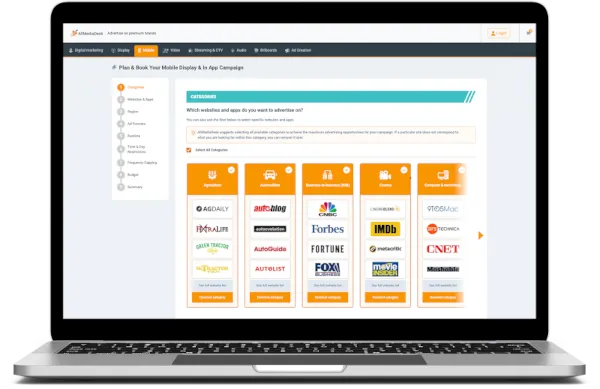How to Improve Performance of Mobile & InApp Campaigns - CTR Benchmarks
Mobile display and video ads—whether on apps or mobile websites—are a powerful way to reach your audience where they spend most of their time. But are they effective?
Yes—when tailored for mobile behavior and optimized smartly.
With the right approach, mobile ads can increase visibility, drive engagement, and boost conversions. The key lies in targeting, creative execution, and smart placement.

How to Improve Mobile Ad Performance

1. Target the Right Audience
- Focus on users genuinely interested in your service or product.
- Use contextual targeting to appear on content that matches your offer—whether it’s tech news, travel blogs, or lifestyle apps.

2. Design for Small Screens
- Make sure your message is clear within seconds.
- Use eye-catching visuals, short headlines, and strong call-to-actions (CTAs).
- For mobile video: Go vertical, keep it under 15 seconds, and add subtitles.

3. Run A/B Tests
- Compare different ad versions: change colors, images, text, and CTA buttons.
- Measure what works—then scale the winners.

4. Pick the Right Placements
- Relevance matters—but so does scale.
- Use high-quality mobile websites and apps through the AllMediaDesk platform to get the best mix of reach and performance.

5. Go Mobile-First
- Use mobile-optimized formats and responsive design.
- Test load times and file sizes—slow ads kill engagement.
- Avoid clutter. Mobile is not the place for small fonts or busy layouts.
Key Metrics to Measure Success
Launching a mobile ad campaign is only half the job—measuring its effectiveness is where the real optimization begins. The right performance metrics give you insights into what’s working, what needs adjusting, and where your budget delivers the best return.
Below are the most important metrics to track when running display or video ads on mobile devices:
Click-Through Rate (CTR)
CTR shows how many people click your ad after seeing it. A higher CTR usually means your ad creative and targeting are relevant and engaging to your audience.
- Why it matters: CTR helps you understand whether your ad is catching attention and prompting action.
- What’s a good CTR? On mobile, the average CTR for display ads based on our experience is around 0.35%.
- Tip: If your CTR is low, try improving your ad copy, design, or targeting.
Pay-Per-Click (PPC)
PPC tells you how much each actual click on your ad costs. It’s calculated by dividing your ad spend by the number of clicks generated.
- Why it matters: PPC helps you evaluate the cost-efficiency of your campaign. You may have a campaign with a slightly lower CTR but a much lower cost per click—which means more traffic for your budget.
- When to optimize: If your PPC is high, consider adjusting your targeting, testing different placements, or simplifying your creative to improve performance without increasing spend.
Cost-Per-Mille (CPM)
CPM measures the cost per 1,000 impressions (views) and is often used when the goal is brand awareness.
- Why it matters: CPM gives you insight into how much visibility you're buying. It’s especially useful for comparing the reach of different campaigns or channels.
- Balance with other metrics: A low CPM might seem attractive, but it only delivers value if your ads also drive meaningful engagement (total amount of clicks, conversions).
Conversions and Conversion Rate (CVR)
While CTR shows interest, conversions show action—like a purchase, sign-up, or app download.
- Why it matters: Tracking conversions helps you understand if your ads are actually delivering business results, not just clicks.
- What to look for: If your CTR is high but conversions are low, revisit your landing page or offer. The post-click experience might need improvement.
Best Mobile Ad Formats
Based on our experience, these are the best-performing mobile formats:
- Medium Rectangle (300×250 px)
A top-performing format for mobile apps and web. - Large Rectangle (336×280 px)
Slightly bigger—great for content-rich pages. - Vertical Video (9:16)
Ideal for full-screen mobile experiences in apps and mobile sites.
Is Mobile Advertising Worth It?
The profitability of mobile ads depends on your product margins and competitive landscape—but when executed well, they drive real results. Mobile advertising is especially powerful for brand building, retargeting, and driving conversions from users already on the go.



